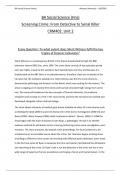BA Social Science (Hons) Abertay University – 1905590
BA Social Science (Hns)
Screening Crime: From Detective to Serial Killer
CRM402: Unit 2
Essay Question: To what extent does Silent Witness fulfil the key
tropes of forensic television?
Silent Witness is a contemporary British crime drama broadcasted through the BBC
television channel BBC One, since 1996. The crime show consists of two episodes spread
over two nights a week at the weekend. Each episode lasts one hour and because it is
broadcasted on the BBC there is no advertisements, therefore, there are no breaks in the
narrative bar the ending to episode one. Silent witness was the first crime drama to
demonstrate pathology and forensics in fine detail, which was exciting for the viewers. The
show is ongoing on its twenty third series and has had consistent high ratings from series
one. This essay will endeavour the key concepts of forensic television, the audience
viewpoint and concept or crime in the social world, and how the narrative has evolved and
developed alongside culture and technology.
The show adopts elements of medical gaze drama relatable to other UK crime dramas such
as Waking the dead (2000-11) and US dramas CSI: Crime Scene Investigation (2000-15) and
Bones (2005-) Mary Poovey (1995) called ‘anatomical realism’ (Gever, 2005). In 1996 the
show began with the main character Dr Sam Ryan, a pathologist. Her job is to identify
evidence and find its attribution to the crime by performing crime scene investigation, post-
mortems. The main character also attends court proceedings, for found evidence to be
actualised as an accountable source about the crime. Her character begins working alone
travelling to different crime scenes and working with different police detectives every week.
In the first few series Dr Ryan is viewed as the hero and master mind behind the attribution
and reasoning of the crime. Dr Ryan’s role is not the detective in the series but has a very
wide range of expertise that are exceptional, portraying a heroic and trusted nature. In the
, BA Social Science (Hons) Abertay University – 1905590
beginning Dr Ryan’s character can relate with the hardboiled tradition lone detective. She
likes working alone and has little family life bar her sister and nephew (Scaggs, 2005). As the
show develops, around series 3, Dr Ryan’s is accompanied by a forensics team which the
viewers are introduced to and get to know over the next five series. By series 8 a new main
character Dr Alexander, very similar characteristics to Dr Ryan’s, is introduced and works her
way to becoming the new Dr Ryan’s in series 17 onwards.
The female characters are important in relevance to mainstream broadcasting, whereby
female characters hold a dominant position in society that is taken seriously (McElroy,
2016). In a way Dr Ryan’s and Dr Alexander’s character’s can be described as an oxymoron,
by standing outside the gendered traditions of the classic female detective and the male
bruiser. Previous female detectives like Miss Marple or Jessica Fletcher, projected a
domestic nature to re-establishing harmony by solving small community crimes (Shuker-
Haines, 1998). The female characters in Silent Witness are not only experts in forensics they
also demonstrate incredible people skills such as good listening, common sense, and
intuitive judgment of character. There is more than a scientific measure of crime, like the
hardboiled tradition detective, social knowledge is used to identify the criminal and locate
the source of social disruption, purifying and restabilizing society (Shuker-Haines, 1998). The
social construction of the hard-boiled detective is usually viewed from a male perspective,
not a female figure. The detective is usually a dominant male character lurking in the
criminal underworld to solve crime through violence and a gain personal victory of pride and
honour in the social world (Ashman, 2017). Interestingly, Silent Witness presents the female
hardboiled characters with positive notions of feminism, meaning there is no supressed
opportunities by authorities as the main characters demonstrating true capabilities of
woman who work in the crime sector (Shuker-Haines, 1998).
The narrative is consistent, each weekly broadcast presents a different story line with the
same characters and narrative. The type of crime investigated is always murder and the
types of criminals are varied. There are serial killers, concealed accidents, greedy people,
self-defence, corrupt gangsters, and drug or people trafficking gone wrong. In the beginning
it was smaller cases within the surrounding area of London, after season 8 the cases are
more widespread over the UK and some cases are worldwide. The episodes always begin
with a dramatic or thrilling opening scene followed by the title scene with a recognisable




